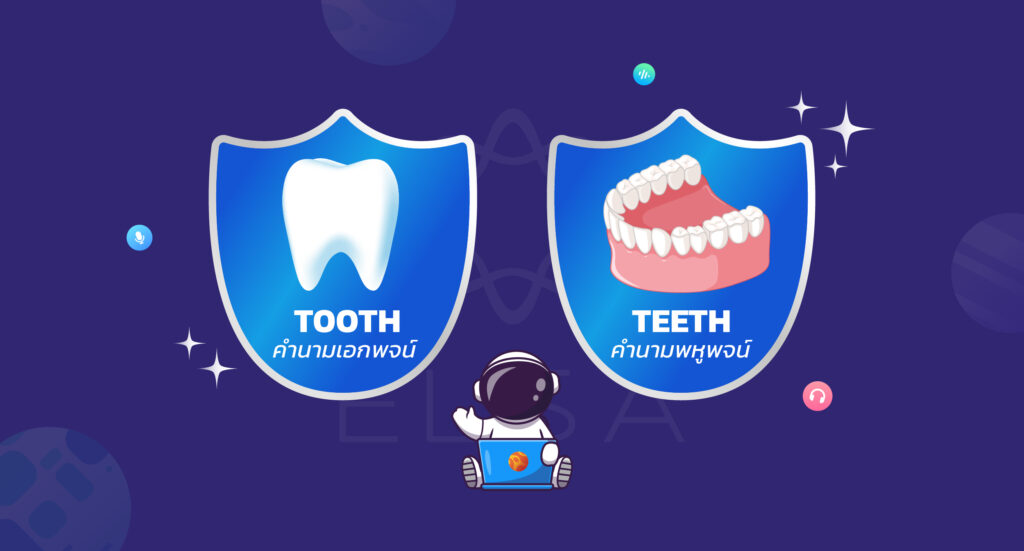คำนามสามารถอยู่ในรูปแบบเอกพจน์หรือพหูพจน์ได้ การพิจารณาว่าคำนามเป็นเอกพจน์หรือพหูพจน์มีความหมายสำคัญเมื่อเราทำแบบฝึกหัดที่เกี่ยวข้องกับการผันกริยา ในบทความนี้เราจะเรียนรู้คํานามเอกพจน์และคำนามพหูพจน์ในภาษาอังกฤษ ในส่วนสุดท้ายเราจะทำแบบฝึกหัดเกี่ยวกับคํานามเอกพจน์และคำนามพหูพจน์นะคะ
คํานามเอกพจน์ในภาษาอังกฤษคืออะไร
คํานามเอกพจน์คือคำนามที่มีเพียงจำนวนเดียว
สอบก่อนเข้าฟรี

ตัวอย่าง Pineapple, apple, coconut, cake, cookie, table
หมายเหตุ คำนามบางคำลงท้ายด้วยตัว “s” แต่คำเหล่านี้ยังคงเป็นคํานามเอกพจน์
ตัวอย่าง
- รายวิชา: Physics, mathematics
- โรค: measles, mumps
- เวลา: eight, months, ten years
- หน่วยวัด: nine pounds, one kilograms, five miles
- ราคา: 800 dollars. 600 dollars
- ประเทศ: The United States, The Philippines
คำนามพหูพจน์ในภาษาอังกฤษคืออะไร
นิยาม
คำนามพหูพจน์ คือคำนามที่มีสองจำนวนขึ้นไป
ตัวอย่าง For apples, three rooms, seven phones, eight television,….
วิธีการออกเสียงท้ายคำนามพหูพจน์
| คำที่มีเสียงเหล่านี้เป็นเสียงสุดท้าย | การถอดเสียง | ตัวอย่าง |
| มีพยัญชนะที่ไม่มีเสียง f, k, p, t | “s” | Roofs, books, lakeds, shops, hopes, hats |
| มีสระและพยัญชนะที่เปล่งออกมา | “z” | Days, birdss, dogss, pens, walls, yearss |
| มีพยัญชนะ s, z, ƒ, tf, dz | “iz” | Horsess, boxess, roses, brushess, watches, villagess, kissess,… |
หมายเหตุว่ามีคำนามหลายคำไม่ลงท้ายด้วยตัว s แต่ยังสามารถเป็นคำนามพหูพจน์ได้
ตัวอย่าง
- คำนามที่อ้างถึงรูปแบบรวม People, army, children, police, cattle,…
- กลุ่มคำนามที่คำคุณศัพท์อยู่ข้างหน้าได้: the poor, the blind, the dumb, the injured, the rich,…
>>> Read more: หลักการเติม s/ es ต่อคำนาม และวิธีออกเสียง s/ es ให้ถูกต้อง

วิธีการเปลี่ยนคำนามเอกพจน์ให้เป็นพหูพจน์
โดยปกติ คำนามจะเติมตัว “s” ต่อลงท้ายเพื่อให้กลายเป็นคำนามพหูพจน์
ตัวอย่าง
– car -> cars
– house -> houses
– ticket -> tickets
– shop -> shops
คำนามที่ลงท้ายด้วย CH SH S X จะเติม “es” ที่ท้ายประโยค
หมายเหตุว่า สำหรับคำที่ท้ายด้วยตัว Z ให้เพิ่มตัว Z สองเท่าแล้วเติม ES ตามปกติ
ตัวอย่าง
– one box -> two boxes
– a watch -> watches
– a class -> classes
– a quiz -> quizzes
คำนามที่ท้ายด้วยตัว Y จะเปลี่ยนเป็น “ies”
ตัวอย่าง
– butterfly -> butteflies
– baby -> babies
คำนามที่ท้ายด้วย O จะเติม “es” ที่ท้ายประโยค
ตัวอย่าง
- mango -> mangoes
- tomato -> tomatoes
- potato -> potatoes
หมายเหตุว่า คำบางคำเติมได้เฉพาะตัว“s” เท่านั้น เช่น photos pianos
คำนามที่ท้ายด้วย F FE FF เราจะตัดออกคำเหล่านี้แล้วเติม “ves” ต่อท้าย
ตัวอย่าง
– a wife -> wives
– bookshelf -> bookshelves
– staff -> staves (หรือ staffs)
คำนามพหูพจน์ผิดปกติในภาษาอังกฤษ
| คำนามเอกพจน์ | คำนามพหูพจน์ |
| ox: วัว 1 ตัว | oxen |
| mouse: หนู 1 ตัว | mice |
| goose: ห่าน 1 ตัว | geese |
| child: เด็กคนหนึ่ง | children |
| man/woman: ผู้ชาย/ ผู้หญิง | men/women |
| sheep: แกะ 1 ตัว | sheep |
| tooth: ฟัน | teeth |
| foot: เท้า | feet |

แบบฝึกหัดเกี่ยวกับคำนามเอกพจน์และคำนามพหูพจน์
แบบฝึกหัดที่ 1 เขียนรูปเอกพจน์ของคำนามต่อไปนี้
- roses →
- boys →
- families →
- potatoes →
- wives →
- photos →
- children →
- sandwiches →
- fish →
- feet →
- lamps →
- cities →
- sheep →
- cliffs →
- roofs →
- thieves →
- pence →
- pianos →
- teeth →
แบบฝึกหัดที่ 2 เปลี่ยนประโยคให้เป็นรูปพหูพจน์
Example: My foot is big. → My feet are big.
- The man is talls.
- The man is fat.
- The children is sad.
- The moused is gray.
- My tooth is white.
แบบฝึกหัดที่ 3 เปลี่ยนประโยคให้เป็นรูปเอกพจน์
Example: The fish are quiet. → The fish is quiet.
- The gees are in the yard.
- The childrened are tired.
- The policemens are old.
- The mice are not hungry.
- The sheep are not ugly.
แบบฝึกหัดที่ 4 ใส่รูปพหูพจน์ของคำนามในวงเล็บ
- These (personed) are protesting against the president.
- The (woman) over there wanted to meet the manager.
- My (child) hate eating Cali pasta.
- I am illé. My (foot) hurt.
- Muslim kill (sheep) in a religious celebration.
- I clean my (tooth) three times a day.
- The (student) are doing the exercised right now.
- The (fish) I bought is in the is fridge.
- They are sending some (man) to fixed the roof.
- Most (housewife) work more than tene hours a day at home.
- Where did you put on the (knife)?
- On the (shelf).
- (Goose) like watere.
- (Piano) are i expensive
- Some (policeman) came to arrest him.
- Where is mi (luggage)?
แบบฝึกหัดที่ 5 เลือกคำตอบที่ถูกต้อง
- All birds are very good at building their_____
- nestes
- neste
- nests
- nestoes
- Donnay and Dougy are planning to sell all their possession and move to Maui in order to become beach_____.
- bumes
- bums
- bum
- bumoes
- We ate both____.
- apple
- appleoes
- applesed
- applese
- We picked some one_____ from the tree.
- orangeses
- orangeoes
- oranges
- orange
- Leaves coverd the two ______ in the woods.
- pathes
- pathed
- paths
- pathese
- Three_____ swam in the river.
- fish
- fishs
- fishes
- fishoes
- I have jush bought three_____
- ox
- oxes
- oxs
- oxen
- Landy knew that many _____ were living in the walled of the old houses.
- mouses
- moused
- mices
- mices
- The hunters never noticed the one ____ by the appletrees.
- deers
- deeres
- deer
- deeroes
- Are the _____chasing the otherd farm animals?
- geese
- gooses
- goose
- goosoes
- You should placed the _____ and spoons to the left of the plates.
- knifes
- knives
- knife
- knifese
- The _____ stood on boxes to saw the parade.
- Child
- Childs
- Children
- Childrens
- Please keeped your hands and ____ inside the car.
- Feet
- Foots
- Foot
- Footes
- Please give me that _____.
- Cissor
- Cissors
- Cissorsescissores
- There are for____in the picture.
- Sheep
- Sheeps
- sheepes
แบบฝึกหัดที่ 6 เปลี่ยนคำนามวลีต่อไปนี้ให้เป็นพหูพจน์
- a table -> tables
- an egg ->…………………………
- a carx ->…………………………
- an orange ->…………………………
- a housse ->…………………………
- a student -> …………………………
- a class ->…………………………
- a boxer->…………………………
- a watch ->…………………………
- a dishs ->…………………………
- a quiz ->…………………………
- a tomato ->…………………………
- a leaf ->…………………………
- a wife ->…………………………
- a country ->…………………………
- a key ->…………………………
- a policeman ->…………………………
- a bamboo ->…………………………
- an ox -> …………………………
- a child ->…………………………
- a tooth ->…………………………
- a goose ->…………………………
คำตอบ
แบบฝึกหัดที่ 1 เขียนรูปเอกพจน์ของคำนามต่อไปนี้
| roses → rose | boys → boy | families → family | potatoes → potato | wives → wife |
| photos → photo | childrend → child | sandwiches → sandwich | fish → fish | feet → foot |
| lamps → lamp | cities → city | sheep → sheep | cliffs → cliff | roofs → roof |
| thieves → thief | pence → penny | pianos → piano | teeth → tooth | bases → base |
แบบฝึกหัดที่ 2 เปลี่ยนประโยคให้เป็นรูปพหูพจน์
1. The man is tall. – The men are tall
2. The woman is fat. – The women are fat
3. The child is sad. – The children are sad
4. The mouse is gray. – The mice are gray
5. My tooth is white. – My teeth are white
แบบฝึกหัดที่ 3 เปลี่ยนประโยคให้เป็นรูปเอกพจน์
1. The geese are in the yard. – The goose is in the yard
2. The children are tired. – The child is tired
3. The policemen are old. – The policeman is old
4. The mice are hungry. – The mouse is hungry
5. The sheep are ugly. – The sheep is ugly
แบบฝึกหัดที่ 4 ใส่รูปพหูพจน์ของคำนามในวงเล็บ
1. These (person) people are not protesting against the president.
2. The (men) men over there want to meet the manager.
3. My (child) children hated eating pasta.
4. I am ill. My (foot) feet hurt.
5. Muslims kill (sheep) sheep in a religioused celebration.
6. I clean my (tooth) teeth for times a day.
7. The (student) students are not doing the exercise right now.
8. The (fish) fish I bought is not in the fridge.
9. They are sending some (woman) men to fix the roof.
10. Most (housewife) housewives worked more than ten hours a day at home.
11. Where did not you put the (knife) knives?
12. On the (shelf) shelves.
13. (Goose) Geese like water.
14. (Piano) Pianos are expensive.
15. Some (policeman) policemen come to arrest him.
16. Where is my (luggage) luggage? – In the car!
แบบฝึกหัดที่ 5 เลือกคำตอบที่ถูกต้อง
| 1-nestse | 2-bums | 3-apples | 4-orangees | 5-paths |
| 6-fishe | 7-oxenss | 8-mices | 9-deerf | 10-geese |
| 11-knives | 12-childrens | 13-feet | 14- scissorse | 15-sheepe |
แบบฝึกหัดที่ 6 เปลี่ยนคำนามวลีต่อไปนี้ให้เป็นพหูพจน์
| 2. eggss | 3. carse | 4. orangese | 5. housese |
| 6. students | 7. classese | 8. boxese | 9. watches |
| 10. dishese | 11. quizzes | 12. tomatoes | 13. leavees |
| 14. wives | 15. countries | 16. keys | 17. policemen |
| 18. bamboos | 19. oxene | 20. childeren | 21. teethe |
| 22. geeses |
ELSA Speak เห็นว่าการทบทวนและการเรียนภาษาอังกฤษต้องมีกระบวนการที่ต่อเนื่องและขยันหมั่นเพียรเพื่อเรียนคำศัพท์และไวยากรณ์ หลังจากเรียนคำศัพท์และไวยากรณ์แล้วควรนำไปประยุกต์ใช้ในชีวิตจริงเพื่อให้การเรียนได้มีประสิทธิภาพที่สุด ตัวอย่างเช่น หลังจากเรียนคำศัพท์และไวยากรณ์เกี่ยวกับคำนามเอกพจน์และคำนามพหูพจน์แล้ว อาจลองเขียนบางประโยคบนโซเชียลเน็ตเวิร์กเพื่อนำไปใช้และจดจำได้ทันทีโดยไม่ลืมความรู้นะคะ
>>> Read more:






